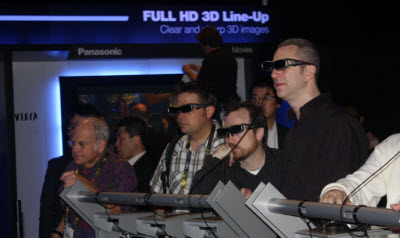 Here are our observations about the top trends at the Consumer Electronics Show in Las Vegas. We spent five days there checking out the gadgets, parties, and press conferences. Check out how well these trends match up against our predictions from before the show.
Here are our observations about the top trends at the Consumer Electronics Show in Las Vegas. We spent five days there checking out the gadgets, parties, and press conferences. Check out how well these trends match up against our predictions from before the show.
3-D TV in the home. Some years, it’s hard to figure out the trends at CES. This year, it was easy because every big company talked about viewing 3-D movies, TV shows and games in the living room. Blame it on Avatar. The advocates include LG Electronics, Toshiba, Samsung, Sharp, Panasonic, Sony, Intel, and Nvidia. Some of the companies gave 30 percent of their press conference airtime to 3-D. Nvidia had the best 3-D viewable images (as far as we saw) on a racing game. That’s because personal computers can use the best dedicated 3-D graphics hardware, making for more realism. Both Panasonic and Samsung unveiled a whole ecosystem of products from glasses to 3-D ready TVs.
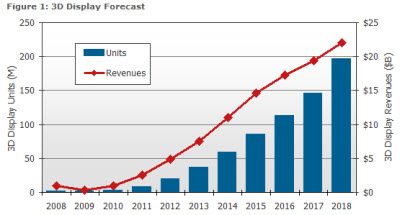 Last year, the 3-D craze was just getting started. But the billion-dollar box office revenues of Avatar made made all of the difference. The movie’s 3-D experience is truly immersive, not formulaic. Another 50 3-D movies will be released in 2010. Movie theaters love them because they give people a reason to come to the theater, and because they can’t be pirated. But TV vendors love it because it will give consumers a reason to go back to stores, even after they’ve already bought their high-definition screens.
Last year, the 3-D craze was just getting started. But the billion-dollar box office revenues of Avatar made made all of the difference. The movie’s 3-D experience is truly immersive, not formulaic. Another 50 3-D movies will be released in 2010. Movie theaters love them because they give people a reason to come to the theater, and because they can’t be pirated. But TV vendors love it because it will give consumers a reason to go back to stores, even after they’ve already bought their high-definition screens.
As good as this sounds, we’re not sure it’s going to be as big as HD TV itself. There are still lots of skeptics out there who won’t watch in 3-D because it gives them a headache. They’re not likely to pay extra for it. And it could be some time still before all of the 3-D ecosystem — with content, cameras, TVs, and glasses — are available in a lot of homes. We don’t expect every movie to be as good as Avatar, either. Samsung and Sharp may be able to boost the market some because they have technologies that can convert 2-D programs to 3-D on the fly. But 3-D is at least off to a good start in 2010 and it will trickle down from the theaters to homes in due time.
 Tablets by the dozen. Apple is expected to launch a tablet computer at the end of the month. But everyone at CES wanted to show off their own cool designs first so that they won’t look like copycats. Microsoft chief executive Steve Ballmer showed off three tablets in his keynote, including Hewlett-Packard’s tablet. But HP was very light on details, perhaps because it wants to wait to see what Apple launches. Most tablet makers would be wise to do the same. But the foundations were all there at CES: touchscreens, swipe controls, content such as eBooks, and chips from companies such as Intel, Qualcomm, Broadcom and Marvell. Tablets have been around for a while, but the new ones should be much more responsive to touch commands. Of all of those who have models in the works, HP will likely be the best challenger to Apple, says Richard Doherty, analyst at the Envisioneering Group. That’s because HP has decades of experience with touchscreens, has a lot of TouchSmart computers already in the market, and has a big collection of touchscreen patents as well. We only wish we saw more of it in action.
Tablets by the dozen. Apple is expected to launch a tablet computer at the end of the month. But everyone at CES wanted to show off their own cool designs first so that they won’t look like copycats. Microsoft chief executive Steve Ballmer showed off three tablets in his keynote, including Hewlett-Packard’s tablet. But HP was very light on details, perhaps because it wants to wait to see what Apple launches. Most tablet makers would be wise to do the same. But the foundations were all there at CES: touchscreens, swipe controls, content such as eBooks, and chips from companies such as Intel, Qualcomm, Broadcom and Marvell. Tablets have been around for a while, but the new ones should be much more responsive to touch commands. Of all of those who have models in the works, HP will likely be the best challenger to Apple, says Richard Doherty, analyst at the Envisioneering Group. That’s because HP has decades of experience with touchscreens, has a lot of TouchSmart computers already in the market, and has a big collection of touchscreen patents as well. We only wish we saw more of it in action.
New devices may bring e-books to the masses. It looks like both device-makers and publishers are expecting books to be a major part of the content on those tablets. After all, Microsoft’s Ballmer showed off the HP tablet’s touchscreen by accessing an Amazon Kindle application and flipping through a few pages of the bestselling novel Twilight. Meanwhile, Plastic Logic launched its Que e-book reader, which is one of the most impressive-looking devices in its market (it had better be, since the device is also substantially more expensive than Amazon’s Kindle).
With these devices, not to mention Apple set to announce its all-but-official tablet/e-book reader later this month, readers’ embrace of e-books as a complement or even replacement for physical books may ramp up dramatically in the next year. As that happens, the question is whether e-book readers can compete against fully-fledged tablets. Are the reader manufacturers in trouble? Will they have to make their devices more tablet-like to compete?
Oh, and the shift may not be limited traditional books — a startup called Graphic.ly, which was also demonstrated on-stage at Ballmer’s keynote, is developing a digital comic book reader and store.
Netbooks are getting more and more attractive. These machines make perfect sense with their smaller screens, low prices, and sole purpose of cruising the web. But the first generation of netbooks that came out about 18 months ago had return rates as high as 40 percent. They didn’t play games, choked on a lot of web sites, and were generally a lousy consumer experience. Despite that, netbooks are selling in the tens of millions and there were dozens of new models at the show. Now, with the newest generation of low-power technology, the category is no longer just a bunch of hype. The machines can live up to their billing. The latest Intel Atom chips give these $400 or so machines a lot of oomph to do tasks that once required full laptops. Toshiba’s new Toshiba Mini NB 350 has an 11 hour battery life. HP’s new Mini 5102 netbook has a touchscreen. About 33 million netbooks sold in 2009, and that should grow 20 percent in 2010, according to market researcher DisplaySearch. The category will get competition from smartbooks, which are hybrids of smart phones and netbooks, and perhaps e-book readers and tablets as well.
Everyone’s jumping on the app store band wagon, and they’re bringing plenty of devices. After Apple found big success with its iPhone/iPod Touch App Store, other smartphone makers followed suit. Now the model is moving to other devices, particularly those netbooks we mentioned. Intel announced AppUp, which netbook makers can customize to offer their own stores to customers. Samsung announced its store too, which appears to use AppUp technology. Netbooks seem like the obvious next step for this model, since they sit between the sophistication of a normal laptop and a smartphone. At the same time, you could see this as a blow for native apps over the “net” part of netbooks, since netbooks are supposed to be all about accessing the web, not downloading applications. Google has been the most vocal about this, declaring that “all apps are web apps” in its forthcoming netbook operating system, Chrome OS.
The vision isn’t limited to netbooks, but encompasses TVs, PCs, and other devices too. Samsung, in particular, promoted its apps’ cross-device capabilities. It’s not about TV apps, or phone apps. It’s about apps that work across all devices, storing your activity so that your behavior on one device carries over the others. As companies release new gadgets (see the tablet trend above) and old devices get web connected (see the TV trend below), these kinds of cross-device features will become more crucial.
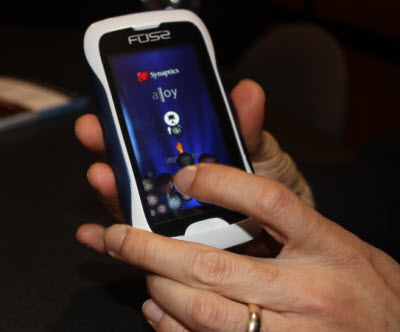 New user interfaces abound. Ever since the iPhone and the Nintendo Wii debuted, the tech industry has been experimenting with new ways to control devices. Touchscreens have infiltrated lots of products, from Microsoft’s pricey Surface tables to everyday cell phones. At the show, Motorola debuted its Backflip phone with a touch surface in the back of a phone, allowing you to control the screen without obstructing your view of it. The iPhone’s accelerometers introduced the intuitive shake or tilt functions that add more nuance to your controls. Synaptics, meanwhile, showed what is possible by combining touch with other controls in its and Fuse and Scrybe demos. This should be quite useful for future phones and tablets.
New user interfaces abound. Ever since the iPhone and the Nintendo Wii debuted, the tech industry has been experimenting with new ways to control devices. Touchscreens have infiltrated lots of products, from Microsoft’s pricey Surface tables to everyday cell phones. At the show, Motorola debuted its Backflip phone with a touch surface in the back of a phone, allowing you to control the screen without obstructing your view of it. The iPhone’s accelerometers introduced the intuitive shake or tilt functions that add more nuance to your controls. Synaptics, meanwhile, showed what is possible by combining touch with other controls in its and Fuse and Scrybe demos. This should be quite useful for future phones and tablets.
Gesture controls are also taking a leap forward. Microsoft said it would launch Project Natal, which has camera-based sensors that can detect your full body movements, for the Xbox 360 in the fall of 2010. Sony was strangely silent about its rival technology debuting this spring. But companies such as GestureTek, Canesta and others showed off their own technologies for controlling TVs or other gear with gestures. It remains to be seen how well users will warm to these new control schemes, and how soon software takes advantage of it.
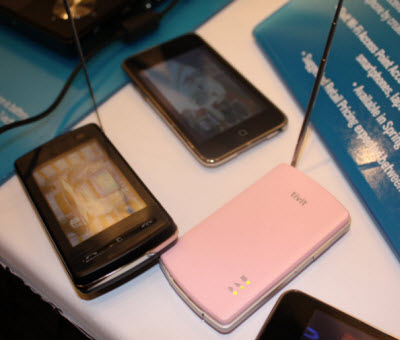 Mobile TV gets competitive. Qualcomm has invested hundreds of millions of dollars into its FloTV business. The company has acquired the spectrum it needs to broadcast mobile digital TV programming wirelessly to cell phones (including the iPhone) and its own FloTV handheld player. But now it has some competition from the Open Mobile Video Coaltion, which has passed a Mobile Digital TV standard. New devices based on the standard were shown at CES, but the battery life and usefulness are still lacking. While Qualcomm has a national network with a wide variety of programming, the Open Mobile group can so far only produce local digital TV programming in 30 cities. The Open Mobile group offers the service for free, while Qualcomm charges a subscription. Unlike the other trends, this one is still emerging and was evident in just a handful of booths. Like digital TV, it may take a long time to evolve. But consumers will probably watch TV on their handhelds, when it comes in crystal clear video and has enough content. A proof point is Telegent, whose chips provide analog TV programming for cell phones around the world. Telegent is lining up an initial public offering on the strength of its international business. If analog TV can take off, then it probably means there will be demand for mobile digital TV.
Mobile TV gets competitive. Qualcomm has invested hundreds of millions of dollars into its FloTV business. The company has acquired the spectrum it needs to broadcast mobile digital TV programming wirelessly to cell phones (including the iPhone) and its own FloTV handheld player. But now it has some competition from the Open Mobile Video Coaltion, which has passed a Mobile Digital TV standard. New devices based on the standard were shown at CES, but the battery life and usefulness are still lacking. While Qualcomm has a national network with a wide variety of programming, the Open Mobile group can so far only produce local digital TV programming in 30 cities. The Open Mobile group offers the service for free, while Qualcomm charges a subscription. Unlike the other trends, this one is still emerging and was evident in just a handful of booths. Like digital TV, it may take a long time to evolve. But consumers will probably watch TV on their handhelds, when it comes in crystal clear video and has enough content. A proof point is Telegent, whose chips provide analog TV programming for cell phones around the world. Telegent is lining up an initial public offering on the strength of its international business. If analog TV can take off, then it probably means there will be demand for mobile digital TV.
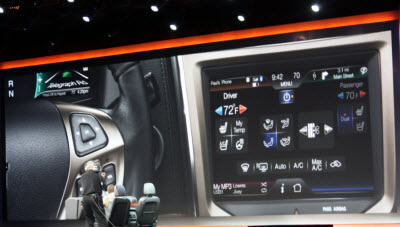 Cars get smarter. Ford has seen a great deal of success with its Sync voice-controlled car electronics system. In surveys, 32 percent of buyers said Sync was important or critical in their decisions to buy a Ford vehicle. Ford hit its target of selling a million vehicles with Sync last May. About 81 percent of customers are satisfied with Sync and 77 percent would recommend it. This week, Ford said that developers can create apps that can run on Sync, it will give users 3G or Wi-Fi access inside the car, and it has redesigned its dashboard to be electronics friendly. You can plug in your iPods, phones, memory cards and other devices into the deck.
Cars get smarter. Ford has seen a great deal of success with its Sync voice-controlled car electronics system. In surveys, 32 percent of buyers said Sync was important or critical in their decisions to buy a Ford vehicle. Ford hit its target of selling a million vehicles with Sync last May. About 81 percent of customers are satisfied with Sync and 77 percent would recommend it. This week, Ford said that developers can create apps that can run on Sync, it will give users 3G or Wi-Fi access inside the car, and it has redesigned its dashboard to be electronics friendly. You can plug in your iPods, phones, memory cards and other devices into the deck.
Not every car is going to be so connected in the future. But Ford’s moves show that the car companies are finally moving to an annual cycle for driving new technology into their vehicles, instead of the usual five years. It’s also heartening to hear that we’re not all heading for a big pile-up. Ford says that Sync lets drivers choose a new song with voice commands in 4.9 seconds, while it takes 30 seconds without it. The company is trying to minimize distractions for the driver even as it adds more stuff for you to do while you’re driving. Ford was just one example of myriad other car-related announcements at CES.
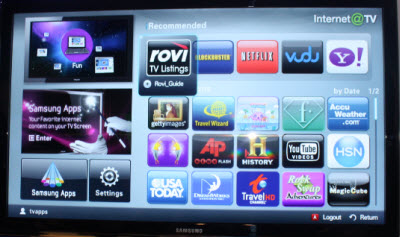 Connected TVs catch on. Web-connected TVs are now proliferating through the model line-ups of consumer electronics companies. Last year, Yahoo launched its Widget Engine to enable TVs to display web sites on a TV using a remote control. Samsung, LG, Toshiba and Sony have all shipped TVs with the Widget Engine. In 2009, sales of web-connected TVs rose 830 percent from a small base, according to the Consumer Electronics Association. This year, growth is expected to be about 129 percent, and Yahoo expects its Widget Engine will be on millions of TVs. That gives the TVs access to thousands of web sites, ranging from Netflix to Pandora. Samsung, which says it captured 75 percent of the connected-TV market in 2009, is adding an app store so that users will have more choice about what they can access via the connected TVs.
Connected TVs catch on. Web-connected TVs are now proliferating through the model line-ups of consumer electronics companies. Last year, Yahoo launched its Widget Engine to enable TVs to display web sites on a TV using a remote control. Samsung, LG, Toshiba and Sony have all shipped TVs with the Widget Engine. In 2009, sales of web-connected TVs rose 830 percent from a small base, according to the Consumer Electronics Association. This year, growth is expected to be about 129 percent, and Yahoo expects its Widget Engine will be on millions of TVs. That gives the TVs access to thousands of web sites, ranging from Netflix to Pandora. Samsung, which says it captured 75 percent of the connected-TV market in 2009, is adding an app store so that users will have more choice about what they can access via the connected TVs.
 Green tech gadgets get real. Green technology is moving from the sounds good, lip-service stage to real products. The big consumer electronics companies halted their arms race of making bigger and bigger flat-panel displays (although there was an 84-inch TV on display in LG’s booth). Instead, they talked up the better energy efficiency of LED TVs and thinner sizes. Hewlett-Packard got rid of some toxic chemicals in its PCs and has switched to entirely degradeable packaging. About 20 companies displayed their wares in a green tech zone on the show floor. And most big TV makers had flat-panel displays in their booths with wattage data.
Green tech gadgets get real. Green technology is moving from the sounds good, lip-service stage to real products. The big consumer electronics companies halted their arms race of making bigger and bigger flat-panel displays (although there was an 84-inch TV on display in LG’s booth). Instead, they talked up the better energy efficiency of LED TVs and thinner sizes. Hewlett-Packard got rid of some toxic chemicals in its PCs and has switched to entirely degradeable packaging. About 20 companies displayed their wares in a green tech zone on the show floor. And most big TV makers had flat-panel displays in their booths with wattage data.

